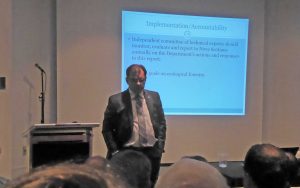Prof Lahey has set a high standard for further discourse about our forests and forestry

A reader of NS Forest Notes waits outside the Legislature for release of the Report
Press Release
————-
Aug 21, 2018 Post
The Report from the Independent Review of Forest Practices in Nova Scotia was released officially at 11 a.m. this morning with posting of the report on the webpage for the Independent Review (the earlier content now replaced with links to The Report) and a media event held 11 am to 12 noon in the Media Room at One Government Place.
There are two volumes:
Executive Summary plus Conclusions and Recommendations, by William Lahey, 82 pages.
– Executive Summary (9 pages) ;
– 1. Introduction (3 pages);
– 2. Leading Themes of Verbal and Written Submissions (4 pages);
– 3. Independent Reviewer’s Conclusions (54 pages) broken into ten subsections with a total of 163 Conclusions each in paragraphs form, some with lists;
– 4. Recommendations (10 pages) of which there are 45.Addendum, also by William Lahey, 252 pages, but with “background material and supporting documents prepared by the expert advisors who provided assistance to the Review. The writing of each section of this addendum has been led by the named author(s). All sections have been reviewed by other members of the Review team. In addition, this addendum includes an appendix of submissions that were prepared at Prof. Lahey’s request by other individuals and organizations.”
I view the Report as a highly commendable piece of work which I believe reflects Prof Lahey’s genuine effort to understand the issues as well as he could (and not just ask others to do so and pass on recommendations); also to “do the impossible” to the extent possible, which is to bring Nova Scotians together on forests and forestry, if not immediately, then to initiate processes that will help that to happen. Those are my interpretations of his efforts and motivation based on a fair amount of interaction, certainly not always harmonious, with Prof Lahey/The Review, including a one-hour event held this morning (9-10 am) for people who had met/made submissions to The Review.
I don’t want to make much comment about the Conclusions & Recommendations until I have had a thorough read of the documents.* I can say that I wasn’t surprised by a lot of what I heard Prof Lahey say about his conclusions and recommendations in the early morning session, e.g., the importance he attaches to adoption of a triad model for the implementation of ecological forestry.
_____________
* My initial reactions as I listened to Prof Lahey’s presentation this morning were fairly negative; a couple of hours reading and somewhat digesting the first 31 pages made me appreciate that the documents contain a lot more than could be readily conveyed or summarized in an hour (as Prof Lahey had said) and dissipated at least some of the negative reactions.
Under Conclusions, Prof Lahey writes concisely but clearly to convey his understanding of the issues. I think the fact that it is all written by a single author who was writing about a field outside of his professional expertise adds to their clarity. It is not written for lawyers but to be read by Nova Scotians with a wide range of backgrounds.
Also, as a single author document, Prof Lahey is doing what he told me he would do when early on I expressed concern about possible Conflicts of Interest on the part of one member of his advisory group: “Trust me, this will be My Report” he said, or words to that effect. So there is no confusion, no passing off of responsibilities to anyone else, no ambiguity about who wrote what. That helps a lot.
 I haven’t got into the Recommendations yet. Based on the summary I heard this a.m., there will certainly be ones that please a lot of people or groups and ones that displease the same people or groups, myself included.
I haven’t got into the Recommendations yet. Based on the summary I heard this a.m., there will certainly be ones that please a lot of people or groups and ones that displease the same people or groups, myself included.
I am very pleased that the Addendum includes the papers commissioned by The Independent Review, e.g., Item 11 The shores of Watercourses (Riparian Areas) by Malcolm Hunter and Laird Van Damme; Item 14 Ecological‐based Silviculture on Crown Lands: Review of DNR’s Forest Management Guide by Robert Seymour.
We don’t have to be worried about confidential reports. The bases of the conclusions and recommendations are there for all to see. Criticize some we might, but Prof Lahey’s standards require us to be logical and transparent about such criticisms, as must be the government – add consultative and accountable – in following up on them.
Well done, Prof Lahey.

